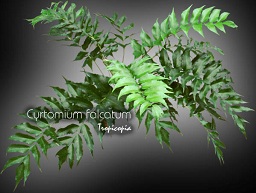Table of contents
Holly-fern

Latin Name: Cyrtomium falcatum
Category: Fern
Family: Dryopteridaceae
Origin: Asia
Climate: Subtropical
Growing Zones: 11, 8
Care Instructions
The Holly-fern (Cyrtomium falcatum) is a subtropical plant that originates from Asia. This fern plant belongs to the Dryopteridaceae family and is well-suited for growing in USDA zones 11, 8.
Complete Care Guide for Holly-Fern (Cyrtomium falcatum)
Watering Requirements
The Holly-fern, or Cyrtomium falcatum, thrives in consistently moist soil but is sensitive to overwatering. It is essential to water the plant when the top inch of soil feels dry to the touch. During the growing season, typically spring and summer, the fern may require more frequent watering, approximately once a week, depending on humidity levels and temperature. In the fall and winter months, reduce watering to allow the plant to rest, ensuring the soil remains slightly moist but not soggy. Always use room temperature water to avoid shocking the roots, and consider using distilled or rainwater if your tap water is high in chlorine or other chemicals.
Light Conditions
The Holly-fern prefers indirect light and can tolerate low-light conditions, making it an excellent choice for indoor environments or shaded garden areas. Direct sunlight can scorch the leaves, leading to browning and damage. Ideally, place your Holly-fern in a location where it receives filtered light, such as near a north or east-facing window. If grown outdoors, consider planting it under the canopy of taller plants or trees to provide dappled sunlight. If you notice the leaves becoming leggy or losing their vibrant green color, it may be a sign that the plant is not receiving enough light, and you should consider relocating it to a brighter spot.
Soil Preferences
The ideal soil for Holly-fern is a well-draining, rich organic mix that retains moisture without becoming waterlogged. A combination of potting soil, peat moss, and perlite or coarse sand works well to provide the necessary drainage and aeration. Aim for a slightly acidic to neutral pH level (around 6.0 to 7.0) for optimal growth. Regular fertilization is not typically necessary, but during the growing season, you can apply a diluted liquid fertilizer every 4-6 weeks to promote healthy growth. Be cautious not to over-fertilize, as this can lead to salt buildup in the soil, which can harm the roots.
Pests and Diseases
Holly-ferns are generally resilient but can be susceptible to common pests such as aphids, spider mites, and mealybugs. Regularly inspect the undersides of leaves and the stems for signs of infestation. If you notice any pests, treat them promptly with insecticidal soap or neem oil, ensuring to follow the product instructions carefully. Additionally, keep an eye out for fungal diseases, particularly in overly moist conditions. Signs of fungal issues include yellowing leaves and a white powdery substance on the foliage. To prevent these problems, ensure proper air circulation around the plant and avoid overhead watering, which can create a humid environment conducive to disease.
Special Care Tips
To maintain the health and beauty of your Holly-fern, consider the following special care tips: First, regularly dust the leaves with a damp cloth to keep them clean and allow for optimal photosynthesis. This practice also helps prevent pest infestations. Second, during the winter months, if your home is particularly dry, consider using a humidifier or placing a tray of water near the plant to increase humidity levels, as Holly-ferns thrive in humid environments. Lastly, repot your Holly-fern every couple of years to refresh the soil and provide more space for growth. When repotting, be gentle with the roots and avoid disturbing them too much to minimize transplant shock.








